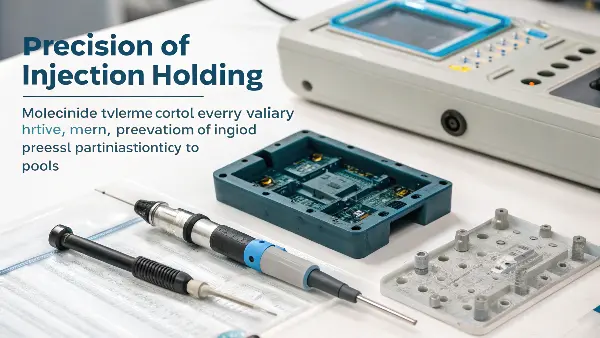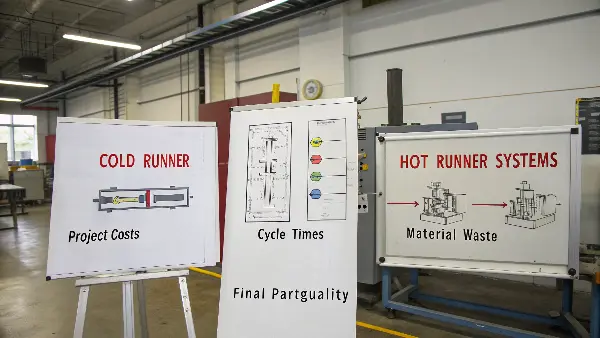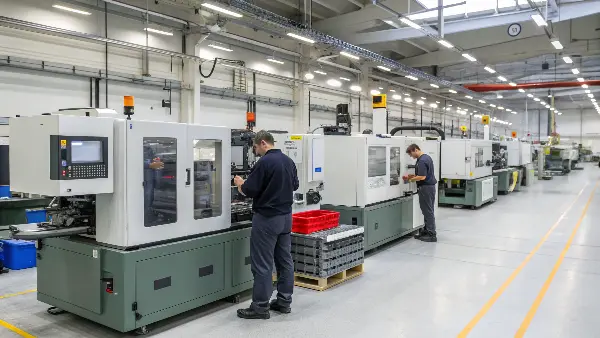Facing complex molds with tight tolerances or high heat? Standard locating rings1 might fail, causing misalignment, flash, and costly defects. You need components designed for these tough jobs.
CKMOLD provides high-precision2, durable, and often insulated locating rings tailored for challenging projects. These ensure accurate alignment, manage thermal issues, and withstand the demands of complex molds, improving part quality and process reliability.
That small steel ring seems simple, but its precision is crucial, especially when molds get intricate, heavy, or run hot. Before diving into how CKMOLD’s solutions excel, let’s solidify our understanding of locating rings and related molding concepts. This foundation helps appreciate why investing in precision components makes such a difference for complex projects.
What Exactly is a Locating Ring in Injection Molding?
Unsure about that ring on the mold’s top plate? Ignoring its role or using a worn one can lead to serious alignment issues, damaged molds, and bad parts down the line. Understanding its basic function is the first step to better molding.
A locating ring is a critical mold component, usually a hardened steel ring on the mold’s stationary half. It precisely fits into the injection molding machine platen’s counterbore, ensuring the mold aligns perfectly with the machine nozzle for consistent injection and part quality.
| Think of the locating ring as the master key ensuring the mold (a complex lock) always engages correctly with the machine (the door frame). It’s bolted securely onto the top clamping plate, centered around the opening for the sprue bushing. The outer diameter (OD) of the ring is manufactured to a specific tolerance to fit snugly into the corresponding recess (counterbore) on the machine’s fixed platen. This mechanical fit physically forces the mold into the correct X-Y position relative to the machine nozzle. If this ring is damaged, worn beyond its tolerance, or the wrong size is installed (a common mistake!), the mold won’t center accurately. This can cause a cascade of problems: flash along the parting line, uneven cavity filling, wear on leader pins and bushings, damage to delicate shut-offs, inconsistent part dimensions, and even potential damage to the machine nozzle or platen. Its job seems basic, but its precision is fundamental to the entire injection molding process, especially for complex or high-tolerance parts where CKMOLD focuses. | Feature | Purpose | Consequence of Poor Condition/Fit |
|---|---|---|---|
| Outer Diameter (OD) | Fits precisely into platen counterbore | Inaccurate mold centering | |
| Mounting | Secures ring to top clamp plate | Ring movement, alignment errors | |
| Material | Typically hardened steel for wear resistance | Faster wear, loss of precision | |
| Concentricity | Aligns sprue bushing to machine nozzle | Injection issues, material leakage | |
| Overall Role | Ensures repeatable, accurate mold positioning | Poor part quality, mold damage |
Just How Precise Can Injection Molding Actually Be?
Need parts with extremely tight tolerances, maybe for medical devices or intricate electronic components? Achieving that level of precision demands control over every single variable, and even tiny misalignments introduced early on can ruin an entire production batch.
Injection molding can achieve very high precision, often down to ±0.001 inches (0.025 mm) or even tighter for small, well-controlled parts and materials. However, factors like material shrinkage, mold quality, process control, and crucially, mold alignment (influenced by the locating ring), determine the final achievable accuracy.

Achieving micrometer-level accuracy isn’t automatic; it’s the result of careful planning and execution across multiple areas. Here’s a breakdown:
- ### Material Selection: Every plastic shrinks as it cools. The amount and uniformity of shrinkage vary hugely between resin types (e.g., amorphous vs. crystalline) and even grades. Fillers like glass fiber introduce anisotropic shrinkage (different rates in different directions). Predicting and compensating for this is key.
- ### Mold Tooling Quality: This is where CKMOLD excels. The mold cavities themselves must be machined to tolerances significantly tighter than the final part requires. Surface finishes, venting, and especially the precision of alignment features like leader pins, bushings, and the locating ring are critical. A high-precision locating ring ensures the mold halves align perfectly from the start.
- ### Process Control: Maintaining consistent melt temperature, injection speed, packing pressure, holding time, and mold temperature is vital. Deviations here directly impact shrinkage and final dimensions. Modern machines offer excellent control, but it needs to be used correctly.
- ### Part Design: Complex geometries, varying wall thicknesses, and sharp corners can introduce stress and warp, making tight tolerances harder to hold consistently. Good design-for-manufacturability (DFM) principles are essential.
-
### Mold Alignment: This is where the locating ring plays its foundational role. If the mold isn’t perfectly centered by the ring, all other precision efforts can be undermined. Clamp forces might be uneven, leading to minute parting line shifts or core deflection. CKMOLD’s precision-ground locating rings minimize this initial alignment error, providing a stable base for achieving tight part tolerances. Factor Affecting Precision How it Influences Accuracy Role of Locating Ring Material Shrinkage Inherent property, needs compensation Ensures consistent alignment for predictability Mold Tooling Quality Cavity dimensions, component fits Provides the primary alignment precision Process Control Consistency of temperature, pressure, time Relies on stable mold positioning Part Design Geometry impacts stress, warp, filling Consistent alignment helps manage flow balance Achieving ±0.001" is possible, but it requires excellence in all these areas, starting with precise mold components like those from CKMOLD.
What Are the Two Main Types of Injection Molding Processes to Know?
Confused by terms like ‘hot runner’ versus ‘cold runner’ when discussing mold designs? Choosing the right process impacts your project’s cost, cycle time, material waste, and final part quality, and it definitely influences component choices like the locating ring.
The two most common injection molding processes are defined by their runner systems: cold runner and hot runner. Cold runner systems solidify the plastic in the channels connecting the sprue to the cavities, ejecting this runner scrap with the part(s). Hot runner systems use heated manifolds and nozzles to keep the plastic molten right up to the gate.

Let’s break down these two fundamental approaches:
- ### Cold Runner Systems:
- How it works: Plastic flows from the machine nozzle, through the sprue, into channels (runners), and then through gates into the cavities. The plastic in the sprue and runners cools and solidifies along with the part. The entire shot (parts + runner system) is ejected.
- Pros: Simpler mold design, generally lower initial mold cost, easier to work with some thermally sensitive materials.
- Cons: Material waste (the runner needs recycling/disposal), often longer cycle times (runner needs to cool), gate removal might require a secondary operation, potentially larger gate vestiges.
- ### Hot Runner Systems:
- How it works: A heated manifold block and heated nozzles maintain the plastic in a molten state from the machine nozzle directly to the gates of the cavities. Only the part solidifies; there’s no runner scrap generated with each shot.
- Pros: No material waste from runners, typically faster cycle times (no runner to cool), eliminates runner removal, often allows for better gate location flexibility and smaller gate vestiges (e.g., valve gates).
- Cons: More complex and expensive mold design, requires precise temperature control, potentially higher maintenance, not suitable for all materials.
-
### Impact on Locating Rings: This is important for complex projects. Hot runner systems introduce significant heat near the center of the mold, right where the locating ring sits. A standard steel locating ring will act as a heat sink, drawing heat away from the hot runner manifold/nozzle area and transferring it to the cooler machine platen. This causes energy waste and can lead to nozzle temperature instability. For hot runner molds, especially those running engineering resins at high temperatures (common in complex automotive or electronic parts), an insulated locating ring (like those CKMOLD provides) is often essential. It creates a thermal break, preserving heat where it’s needed, saving energy, and ensuring stable processing. For simpler cold runner molds, a standard high-quality steel ring might suffice unless extreme precision or very heavy mold weight demands more. Feature Cold Runner System Hot Runner System Locating Ring Implication Runner Scrap Yes No Less direct impact Cycle Time Often Longer Often Shorter Less direct impact Mold Cost Lower Higher Less direct impact Mold Complexity Simpler More Complex Less direct impact Thermal Load Lower near center Higher near center Insulated ring often needed What Does ‘Rapid Injection Molding’ Really Mean?
Need functional prototypes or low-volume production parts delivered fast? Traditional production tooling can take weeks or even months to build, significantly delaying product development cycles and market launches. Is there a quicker way?
Rapid injection molding uses techniques like aluminum molds instead of steel, simplified tooling features (less complex cooling/ejection), and streamlined manufacturing processes to produce real injection-molded parts in much shorter lead times (typically days or a few weeks) compared to traditional production tooling.

Rapid injection molding isn’t a fundamentally different process of melting and injecting plastic, but rather a different approach to toolmaking optimized for speed. It bridges the gap between 3D printing (often different materials/properties) and full-scale production tooling. Here’s what characterizes it:
- ### Mold Material: Often uses high-grade aluminum alloys instead of traditional tool steels (like P20 or H13). Aluminum is much faster to machine, reducing tool build time significantly. However, it’s softer and less durable than steel, limiting tool life (typically good for hundreds to maybe tens of thousands of parts, depending on complexity and material, versus hundreds of thousands or millions for steel).
- ### Tool Design Simplification: To further speed things up, molds might have simpler cooling channels, manual inserts instead of automated slides/lifters where possible, and potentially fewer cavities. The focus is on getting functional parts quickly, sometimes sacrificing maximum optimization or longevity.
- ### Process Focus: The entire workflow, from CAD review to mold manufacturing and molding, is optimized for speed. This might involve dedicated equipment and personnel focused solely on rapid turnaround.
- ### Use Cases: Ideal for functional prototyping (testing design with the actual production material), bridge tooling (filling the gap while production steel molds are built), pilot runs, and low-volume end-use part production where the required quantities don’t justify expensive steel tooling.
-
### Role of the Locating Ring: Even in rapid molding, precise alignment is still critical. Prototypes often need to be tested for fit and function, requiring accurate dimensions. While the mold base might be aluminum or simplified, it still needs to mount correctly in the molding machine. Using a quality, accurately sized locating ring (standard steel is often sufficient here unless specific thermal needs exist) ensures the rapid mold seats properly and consistently. CKMOLD provides standard dimension rings suitable for these rapid tooling bases, ensuring that speed doesn’t come at the cost of fundamental alignment accuracy. While extreme durability isn’t the primary focus like in high-volume steel tools, the initial precision provided by the ring remains essential for getting meaningful results from rapid prototypes. Aspect Rapid Injection Molding Traditional Production Molding Locating Ring Need Tool Material Often Aluminum Typically Steel (P20, H13 etc.) Standard precision needed Lead Time Days / Few Weeks Weeks / Months Standard precision needed Tool Life Lower (hundreds – few 10k shots) High (100k – millions shots) Durability less critical Tool Cost Lower Higher Cost-effective precision okay Complexity Often Simplified Can be Highly Complex Standard precision needed Purpose Prototypes, Bridge, Low Volume High Volume Production Precision always matters Conclusion
Complex injection molding projects demand more than just standard components. Achieving tight tolerances, managing heavy molds, handling high temperatures with hot runners, and even ensuring accuracy in rapid tooling requires careful component selection. CKMOLD delivers the precision locating ring solutions—durable, accurate, and thermally managed when needed—to guarantee reliable mold alignment and support the success of your most challenging projects.
